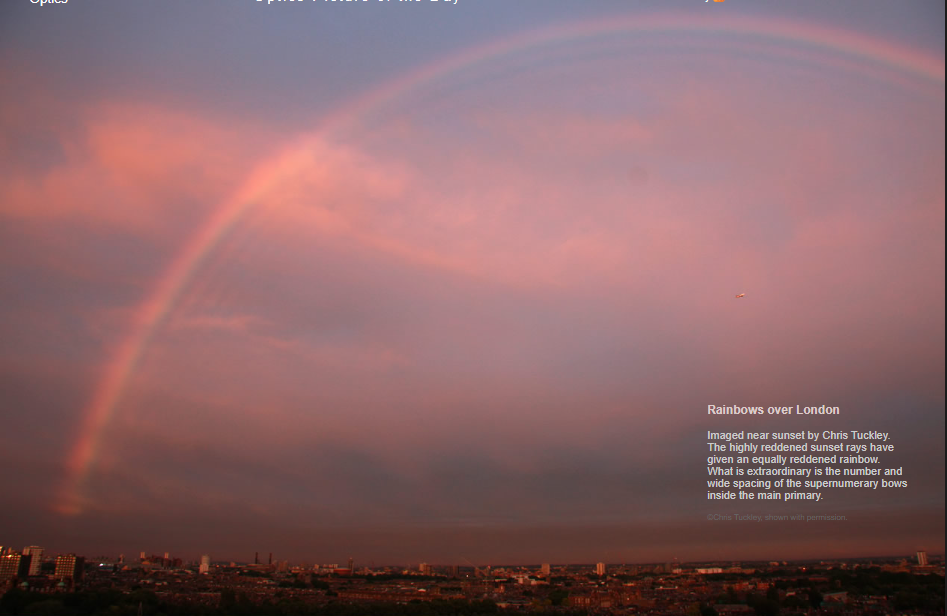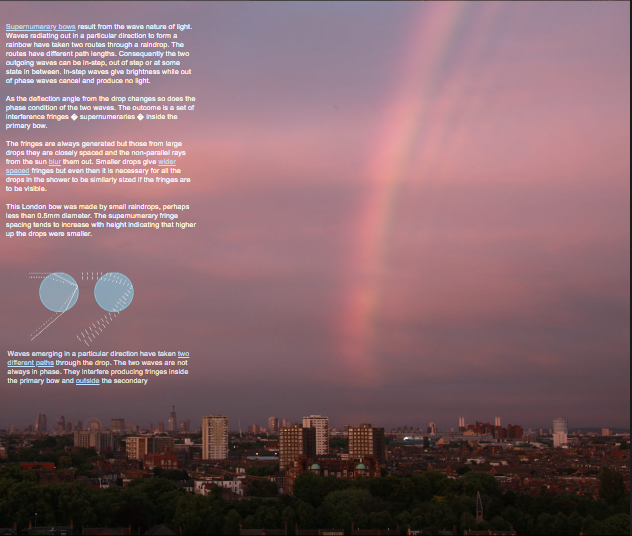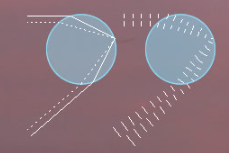OPOD - Sunset Rainbows, London
OPOD - Sunset Rainbows, London: A Spectacular Display of Atmospheric Optics
London, known for its bustling streets and iconic landmarks, occasionally treats its residents and visitors to a breathtaking display of atmospheric optics. Such was the case when Chris Tuckley captured a stunning image of rainbows over the city at sunset. The reddened hues of the sunset rays beautifully complemented the equally reddened rainbow, creating a sight that was nothing short of extraordinary.
The Phenomenon of Supernumerary Bows
One of the most fascinating aspects of this particular rainbow display is the presence of supernumerary bows within the primary rainbow. These additional bows result from the wave nature of light. As light waves radiate out in a specific direction to form a rainbow, they take two different routes through a raindrop. Due to the difference in path lengths, the two outgoing waves can be in-step, out of step, or somewhere in between. In-step waves contribute to brightness, while out-of-phase waves cancel each other out, producing no light.
Interference Fringes and their Characteristics
As the deflection angle from the raindrop changes, so does the phase condition of the two waves. This variation in phase gives rise to a series of interference fringes, known as supernumeraries, inside the primary rainbow. These fringes are always present but are often blurred out by non-parallel rays from the sun and closely spaced in rainbows formed by large drops. However, in the case of smaller raindrops, like those observed in London, the wider spacing of the fringes allows them to be more clearly visible.
The Role of Raindrop Size and Uniformity
To witness the distinct supernumerary fringes, it is crucial for all the drops in the rain shower to be similarly sized. In the case of the London rainbow, small raindrops, measuring less than 0.5mm in diameter, were responsible for the mesmerizing display. Interestingly, the spacing between the supernumerary fringes tends to increase with height, indicating that higher up in the atmosphere, the raindrops were smaller in size.
A Stunning Interplay of Waves and Interference
The interplay of waves and interference within raindrops gives rise to a captivating spectacle. Waves emerging in a specific direction take two different paths through the drop, resulting in a phase difference. This phase difference causes interference, producing fringes not only inside the primary bow but also outside the secondary bow. The presence of these additional fringes adds an extra layer of beauty and complexity to the overall rainbow formation.
Unveiling the Magic of Atmospheric Optics
Atmospheric optics never ceases to amaze us with its intricate phenomena. From the vivid colors of a sunset to the ethereal display of rainbows, these optical wonders remind us of the sheer beauty and complexity of our natural world. Capturing such moments, like Chris Tuckley did with his photograph of sunset rainbows over London, allows us to appreciate the magic that lies within our atmosphere.
Conclusion
The occurrence of supernumerary bows within rainbows is a remarkable phenomenon that arises from the wave nature of light and the interference of waves within raindrops. The spacing and visibility of these fringes depend on the size and uniformity of the raindrops. The image captured by Chris Tuckley in London showcases a vivid example of supernumerary bows, where small raindrops created distinct and widely spaced fringes within the primary rainbow. These awe-inspiring displays of atmospheric optics serve as a reminder of the intricate and captivating wonders that surround us every day.

Rainbows over London
Imaged near sunset by Chris Tuckley. The highly reddened sunset rays have given an equally reddened rainbow. What is extraordinary is the number and wide spacing of the supernumerary bows inside the main primary.
©Chris Tuckley, shown with permission.

Supernumerary bows result from the wave nature of light. Waves radiating out in a particular direction to form a rainbow have taken two routes through a raindrop. The routes have different path lengths. Consequently the two outgoing waves can be in-step, out of step or at some state in between. In-step waves give brightness while out of phase waves cancel and produce no light.
As the deflection angle from the drop changes so does the phase condition of the two waves. The outcome is a set of interference fringes � supernumeraries � inside the primary bow.
The fringes are always generated but those from large drops they are closely spaced and the non-parallel rays from the sun blur them out. Smaller drops give wider spaced fringes but even then it is necessary for all the drops in the shower to be similarly sized if the fringes are to be visible.
This London bow was made by small raindrops, perhaps less than 0.5mm diameter. The supernumerary fringe spacing tends to increase with height indicating that higher up the drops were smaller.

Waves emerging in a particular direction have taken two different paths through the drop. The two waves are not always in phase. They interfere producing fringes inside the primary bow and outside the secondary
Note: this article has been automatically converted from the old site and may not appear as intended. You can find the original article here.
Reference Atmospheric Optics
If you use any of the definitions, information, or data presented on Atmospheric Optics, please copy the link or reference below to properly credit us as the reference source. Thank you!
-
<a href="https://atoptics.co.uk/blog/opod-sunset-rainbows-london/">OPOD - Sunset Rainbows, London</a>
-
"OPOD - Sunset Rainbows, London". Atmospheric Optics. Accessed on April 23, 2024. https://atoptics.co.uk/blog/opod-sunset-rainbows-london/.
-
"OPOD - Sunset Rainbows, London". Atmospheric Optics, https://atoptics.co.uk/blog/opod-sunset-rainbows-london/. Accessed 23 April, 2024
-
OPOD - Sunset Rainbows, London. Atmospheric Optics. Retrieved from https://atoptics.co.uk/blog/opod-sunset-rainbows-london/.